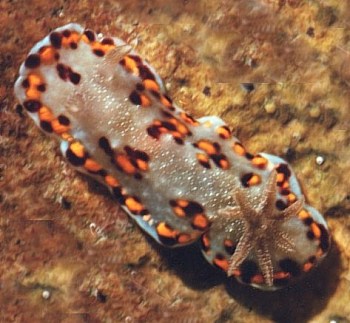
Chromodoris naiki
Valdés, Mollo & Ortea, 1999
Order: NUDIBRANCHIA
Suborder: DORIDINA
Superfamily: EUDORIDOIDEA
Family: Chromodorididae
PHOTO
Mandapam, Tamil Nadu, India, May 1998. Length of preserved animal 13mm. Photo: Ernesto Mollo.
RELATED TOPIC
Chromodoris naiki is pale gray-brown species, with a pale blue band at the edge of the notum. Along the margin and in the central part of the dorsum, there are scattered large spots of dark purple. Immediately inside the area of outer purple spots there is an area of reflective yellow or orange-yellow mantle glands. There are also yellow or orange-yellow mantle glands, associated with the dark purple spots in the center of the dorsum. Numerous, small opaque white spots are scattered all over the central part of the dorsum. The rhinophore clubs and gill are gray-brown. The bases of the rhinophores are translucent gray. There are numerous small opaque white spots arranged in distinct rows along the edges of the rhinophoral lamellae and gill pinnae. The gill consists of six unipinnate branchial leaves. The perfoliate rhinophores are composed of 20 lamellae.
The species is named after Dr. Chandrakant G. Naik, National Institute of Oceanography, Goa, India, for his support to Ernesto Mollo during his field work in the area.
Chromodoris naiki is externally very similar to Chromodoris kitae Gosliner, 1994, described from Madagascar. However, there are several external and internal differences that clearly separate both species. In C. kitae the yellow glands are only present in the mantle margin (see Gosliner, 1994), whereas in C. naiki they are also in the center of the dorsum, associated with the purple spots. In addition, C. naiki has a number of small white spots in the center of the dorsum that are absent in C. kitae. The number of branchial leaves is also different between both species, C. kitae has eight whereas C. naiki has six. So far, C. naiki is only known from Mandapam, southern India.
References:
• Gosliner, T.M. (1994) New species of Chromodoris and Noumea (Nudibranchia: Chromodorididae) from the western Indian Ocean and southern Africa. Proceedings of the California Academy of Sciences, 48: 239-252.
• Valdés, A., Mollo, E. & Ortea, J. (1999) Two new species of Chromodoris (Mollusca, Nudibranchia, Chromodorididae) from Southern India, with a redescription of Chromodoris trimarginata (Winckworth, 1946). Proceedings of the California Academy of Sciences, 51: 461-472.
Valdes, A., 2000 (July 23) Chromodoris naiki Valdés, Mollo & Ortea, 1999. [In] Sea Slug Forum. Australian Museum, Sydney. Available from http://www.seaslugforum.net/find/chronaik
Related messages
Re: Chromodoris naiki from Ratnagiri, India
May 29, 2009
From: Vishal Bhave
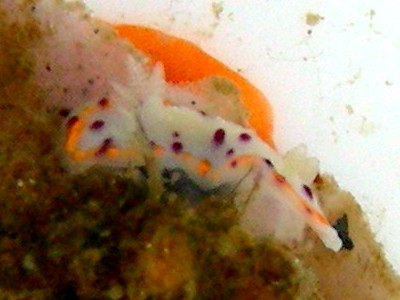
Concerning message #22316:
Got 2 specimens of Chromodoris naiki both the same color but size was less than 2 mm, so can't get best image.
Those are juveniles ?
Locality: Rock patch, mandavi, Ratnagiri, 1.5 feet, Maharashtra, India, Arabian sea, 27 May 2009, Intertidal, rocky patch with some loose rocks and rock pools. Length: 2-3 mm. Photographer: Vishal Bhave.
Vishal Bhave
vishalbhave@gmail.com
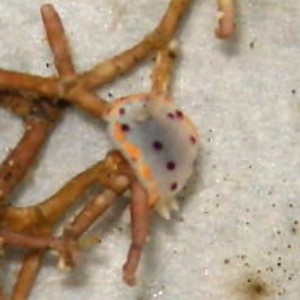
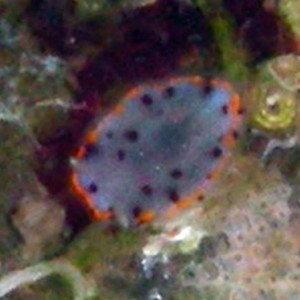
Dear Vishal,
Yes these are juvenile. Thanks for another photo, showing a slightly different colour variation. As I discuss in your earlier message [# 22316], I have no doubt that this is the species that Winckworth named Glossodoris bombayana. The only difference in his description is that he describes the spots as being black rather than purple, but as we can see in the few photos on the Forum - as C. naiki - the colour of the spots range from quite a light purple to a deep reddish brown. I am sure they are never black but some people have difficult in distinguishing deep purple from black. When you consider all other aspects of the colour pattern down to the greenish tinge and small white spots on the mantle, and all the underside being white I am sure C. naiki is a synonym of G. bombayana.
Before I change the name on the Forum I would welcome any comments.
Best wishes,
Bill Rudman
Chromodoris naiki from Ratnagiri, India
March 9, 2009
From: Vishal J Bhave.
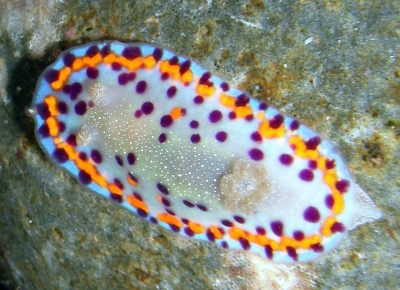
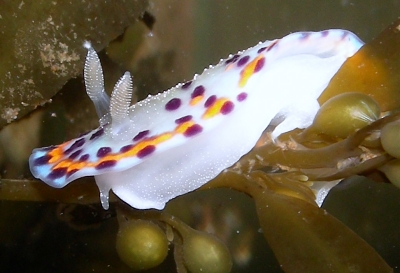
Concerning message #2760:
It was found in the rock pool with narrow mouth. This is a rocky area with many rockpools with lots of hydroids,sponges and alga.
It looks like Chromodoris naiki but for me it is too confusing to identify from externally.
Locality: Mandavi (Black sea), Ratnagiri, 2 feet, Maharashtra, India, Arabian sea, 23 January 2009, Intertidal, in rockpool. [lat. - 16.9858, long. - 73.2730]. Length: 3 cm. Photographer: Vishal Bhave.
Vishal Bhave
vishalbhave@gmail.com
Bhave, V.J., 2009 (Mar 9) Chromodoris naiki from Ratnagiri, India. [Message in] Sea Slug Forum. Australian Museum, Sydney. Available from http://www.seaslugforum.net/find/22316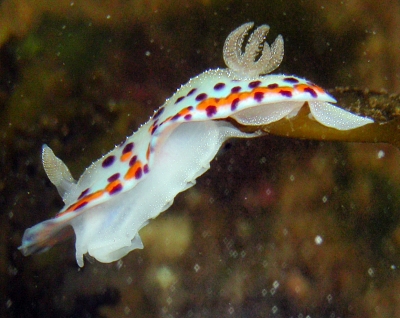
Dear Vishal,
This is a valuable addition to our knowledge. When C. naiki was first described, my first thought was its similarity to C. kitae, which I had previously thought was very similar to C. tumulifera. Valdés, Mollo & Ortea (1999), when describing C. naiki also noted its similarity to C. kitae but considered the presence of orange spots in the centre of the mantle as well as in the submarginal band, and the fine white spots, to be chracters distinguishing C. naiki from C. kitae. They also considered that the two species could be distinguished on gill numbers [6 in C. naiki; 8 in C. kitae]. Your animal appears have 7 gills. I have difficulty that the number of gills is so precise in these species.
Your animal also differs from 'typical' C. naiki in having the orange spots mostly confined to a submarginal mantle band. What makes your animal interesting is that it essentially identical to a species described from Bombay [Mumbai] -C. bombayana Winckworth, 1946. The only difference is that he describes the dark purple spots as black. Otherwise he describes the greenish background colour, the fine white spots on the gills, rhinophores and mantle, and the submarginal band of coalescing orange spots. I didn't recognise the similarity between C. naiki and C. bombayana previously because the only specimens known were those in the original description with many orange spots coalescing with the purple spots in the centre of the mantle. if you find further specimens of this species it would be interesting to see more photos so we can get a better idea of its colour variability.
-
Winckworth, H. C. (1946) Glossodoris from Bombay. Proceedings of the Malacological Society of London, 26, 155-160.
Best wishes,
Bill Rudman
Chromodoris naiki from India
July 25, 2000
From: Ángel Valdés
Dear Bill,
Here is a description and photographs of the recently described Chromodoris naiki and its anatomy. It is only known from Mandapam, southern India.
References
Valdés, A., Mollo, E. & Ortea, J. (1999) Two new species of Chromodoris (Mollusca, Nudibranchia, Chromodorididae) from Southern India, with a redescription of Chromodoris trimarginata (Winckworth, 1946). Proceedings of the California Academy of Sciences, 51: 461-472.
Ángel Valdés
avaldes@calacademy.org
Valdes, A., 2000 (Jul 25) Chromodoris naiki from India. [Message in] Sea Slug Forum. Australian Museum, Sydney. Available from http://www.seaslugforum.net/find/2760Dear Ángel,
Thanks for the information. I hope this and the information you have also sent on Chromodoris mandapamensis, is only the first of many.
Best wishes,
Bill Rudman.
